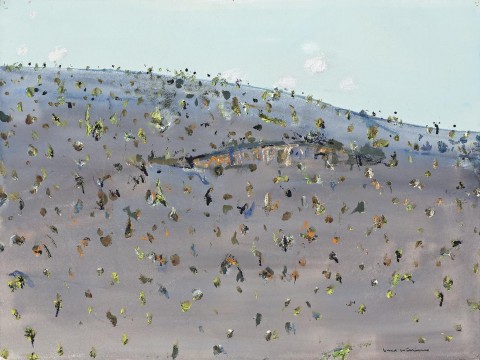LYSTERFIELD, c.1968
FRED WILLIAMS
gouache on paper
57.0 x 75.5 cm
signed lower right: Fred Williams
Clifford Last, Melbourne, acquired directly from the artist
Gallery 460 and Sculpture Park, New South Wales
Private collection, Sydney
Great Australian Artists of the Twentieth Century, Lake Macquarie City Art Gallery, New South Wales, July 1992
We are grateful to Lyn Williams for her assistance with this catalogue entry.
From 1967 onwards, Fred Williams returned to the source of his minimal landscape paintings, increasing the frequency of his outdoor sketching trips, particularly to Ferntree Gully and Lysterfield, at the foot of the Dandenong Ranges. The gouache sketches completed during these trips provided source material, and a passage between a literal impression of the landscape dotted with eucalypts and its further translation into the iconic Williams reductive script, usually in oil paint on canvas. From this crucible of formal innovation comes Lysterfield, c.1968. Like many other gouaches and oils from this period, it has a tripartite division, concentrating much of his gestural information in a central band across the paper – the rolling crest of a hill with a crown of trees protruding from the horizon. The puncture marks in each corner, where the artist tacked his paper onto boards taken in to the bush attest to the immediacy of Williams’ view. Softly billowing clouds suspended in the pale blue sky further inscribe this sketch in time and space, this Lysterfield was an investigation into space and colour executed in real-time, in situ and en plein air.
Although the landscape is sparse, Williams creates a view with delicate tension. While the horizon line plunges steeply towards the left, another knoll protrudes in the centre, its opposing angle lending texture to the topography. Like an elite athlete trimming excess resistance to increase efficiency, Williams’ mark-making process was centred around an economy of means. He is famous for reducing the vegetation of the Australian bush to minute gestures, daubs and swift brushstrokes. These marks are smattered across a thin wash, here in a velvety mauve colour (not dissimilar to the ground of Australian Landscape, 1969, lot 25), their intensity and colours allowing the forms to advance and recede across the shallow picture plane, to quote James Gleeson, a ‘flickering constellation of little shadows and glittering highlights’.1
The purposeful irregularity of Williams’ brushstrokes is at the heart of his formal invention, allowing the artists to express a range of forms, both tangible and ephemeral – from a thicket of vegetation, to a passing shadow or plunging crevasse. This masterly touch and careful placement nevertheless respects the viewers’ visual understanding and autonomy. Visual literacy here is earned, not spoon-fed. To support his limited visual vocabulary, often devoid of overt focal points and narrative structure, light emanates from within his medium. Delicate movement is described through startling nuances of electric colour, the ambiguity of their tonal contrasts making the features of this landscape vacillate in and out of focus. Working in gouache, these radical colour choices preceded Williams’ brief adoption of synthetic polymer paints (encouraged by Albert Tucker), demonstrating the artist’s long-standing pre-occupations with colour and its relative intensity over time, from fresh application in the field to dried and affected by bright sunlight.
Lysterfield, c.1968, was first given by the artist as a gift to the English born sculptor Clifford Last. In 1972, both Last and Williams sat together on the Acquisitions Committee of the Australian National Gallery, and some time around then, a good, old-fashioned ‘artist swap’ was arranged between the two. Last acquired this gouache, while Williams chose a sculpture – one that still remains in the collection of Lyn Williams, the artist’s widow.2
1. Gleeson, J., 1963 cited in AGNSW, https://www.artgallery.nsw.gov.au/collection/works/OA6.1965/
2. Conversation between Chris Deutscher and Lyn Williams, 5th March 2019
LUCIE REEVES-SMITH
